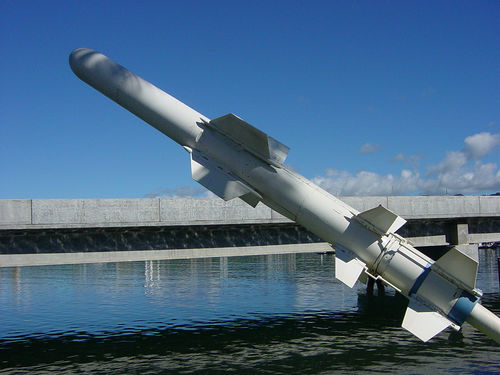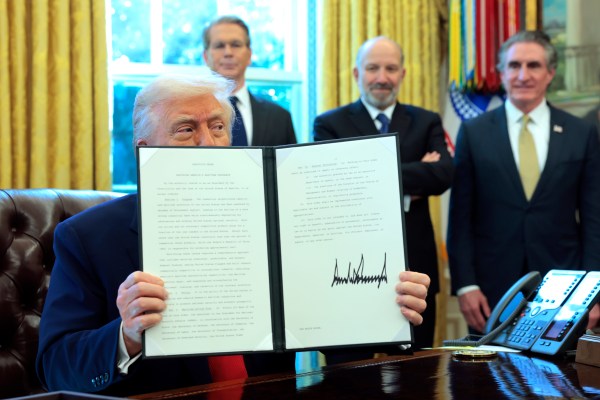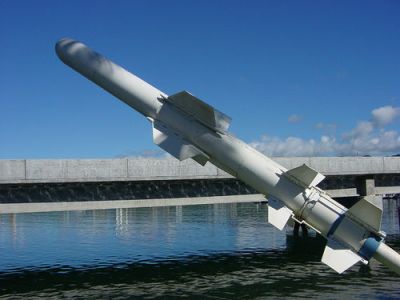The Department of Defense announced on April 7 that the Navy had awarded a procurement contract for 400 Harpoon anti-ship cruise missiles for Taiwan. On its face, the announcement is certainly welcome news. The missiles will accompany the new Harpoon Coastal Defense System (HCDS), which can play a potentially pivotal role in helping Taiwan deter aggression from Beijing, namely an amphibious assault or maritime blockade.
What the announcement actually reveals, though, is that the U.S. foreign military sales program is far too slow and in dire need of reform.
The State Department notified Congress of its decision to approve a possible foreign military sale (FMS) to Taiwan on October 26, 2020. That notification included 400 RGM-84L-4 Harpoon Block II Surface Launched Missiles, 100 launcher transporter units, 25 radar trucks, and associated support equipment and services. While the Navy awarded the contract for the 100 launchers and 25 radar units in March 2022, the contract for the accompanying missiles remained elusive—until this month.
The contract award for the missiles came almost two-and-a-half years after the administration notified Congress of the possible sale. That’s almost as long as it took the United States to prepare and launch the D-Day landings after entering World War II. In other words, completing the paperwork (developing and finalizing a contract) so the manufacturer could begin to bend metal and build the missiles for Taiwan took the U.S. government almost as long (not counting modest pre-war preparations) as it took to prepare for one of the largest amphibious invasions in human history.
Speaking of amphibious invasions with history-changing consequences, the whole point of delivering the HCDS to Taiwan is to convince Beijing that it cannot accomplish its objectives in Taiwan with force at an acceptable cost. Vladimir Putin’s invasion of Ukraine reminds us that deterrence is better than dealing with the consequences of an invasion that might have been avoided. But the People’s Republic of China is in the midst of the most aggressive military expansion and modernization effort in its history, making deterrence easier said than done.
To make matters worse, the deliveries of the Harpoon missiles to Taiwan are not expected to be complete before March 2029, thanks in part to the delay in awarding the contract. And if what’s past is prologue, that may be an optimistic estimate. A June 8, 2022, U.S. Government Accountability Office report stated that “over half” of 29 major defense acquisition programs reviewed reported delays in the previous year.
The additional delay in the Harpoon missiles’ delivery could prove particularly costly. U.S. military leaders have warned that Beijing could launch its aggression against Taiwan by 2027. Indeed, Beijing concluded three days of aggressive naval and air military exercises around Taiwan on April 10 that Chinese state television referred to as a “multi-directional island-encompassing blockade situation.”
What is most concerning is that Taiwan needs the HCDS system more than any other system that is backordered in the FMS debacle. The ground-based system will provide valuable additional anti-ship capacity that can help deter both an invasion and a maritime blockade scenario by placing even the most advanced Chinese warships at risk. Moreover, the mobility of the launchers will make them more difficult for the Chinese military to target, creating dilemmas for military planners contemplating aggression.
The war in Ukraine has demonstrated the value of anti-ship cruise missiles: Ukrainian “Neptune” anti-ship cruise missiles struck and sank the Moskva, the flagship of the Russian navy’s Black Sea fleet. This pushed the Russian navy farther off the Ukrainian coastline, reducing the risk of amphibious assault and allowing the Ukrainian forces greater operational flexibility.
Ukraine also provides another great example relevant to the Taiwan FMS effort. As we have previously argued, the effort to provide Ukraine with a “MacGyver-ed” ground-launched Harpoon missile capability is a great model for Taiwan. The U.S. and Danish navies and Boeing quickly cobbled together a handful of ground launchers and older missiles to permit Kyiv to continue to place Russian Black Sea assets at risk as Ukraine’s own missile inventory dwindled.
William LaPlante, under secretary of defense for acquisition and sustainment, said “two Russia ships were sunk with those Harpoons.”
In the case of Taiwan, the United States could repurpose launchers from decommissioned U.S. Navy ships and modify and provision older Harpoon Block 1 C missiles. With some Boeing “duct tape,” the United States could MacGyver together a mix of mobile (on a vehicle) and transportable (basically a pallet that can be moved) systems to get 32 to 64 missiles tubes and 64 to 128 actual missiles delivered in a matter of 18 to 30 months. This could beat (and augment) the new procurement contract by several years.
The foreign military sales system in general, and Taiwan’s procurement of HCDS in particular, require serious attention from Congress and the State and Defense departments. Congress should scrutinize how services and contracting officers contributed to unacceptable delays between congressional notification and contract award. Lawmakers should also demand specific solutions from the administration and industry on how to expedite delivery of Taiwan’s HCDSs and other critical counter-intervention weapon systems, such as Javelin and Stinger.
There is one more thing Congress can do: work with the Navy and Boeing to implement a MacGyver Harpoon solution for Taiwan. If it can be done for Ukraine, it can be done for Taiwan.
Unfortunately, the situation in the Taiwan Strait is increasingly dire, and the U.S. government is dawdling when it needs to be sprinting to deliver arms to a beleaguered partner. The good news is that the United States has demonstrated it can move quickly when threats to core interests necessitate doing so. It’s time to take the lessons we’ve learned from Ukraine and apply them to Taiwan.





Please note that we at The Dispatch hold ourselves, our work, and our commenters to a higher standard than other places on the internet. We welcome comments that foster genuine debate or discussion—including comments critical of us or our work—but responses that include ad hominem attacks on fellow Dispatch members or are intended to stoke fear and anger may be moderated.
With your membership, you only have the ability to comment on The Morning Dispatch articles. Consider upgrading to join the conversation everywhere.